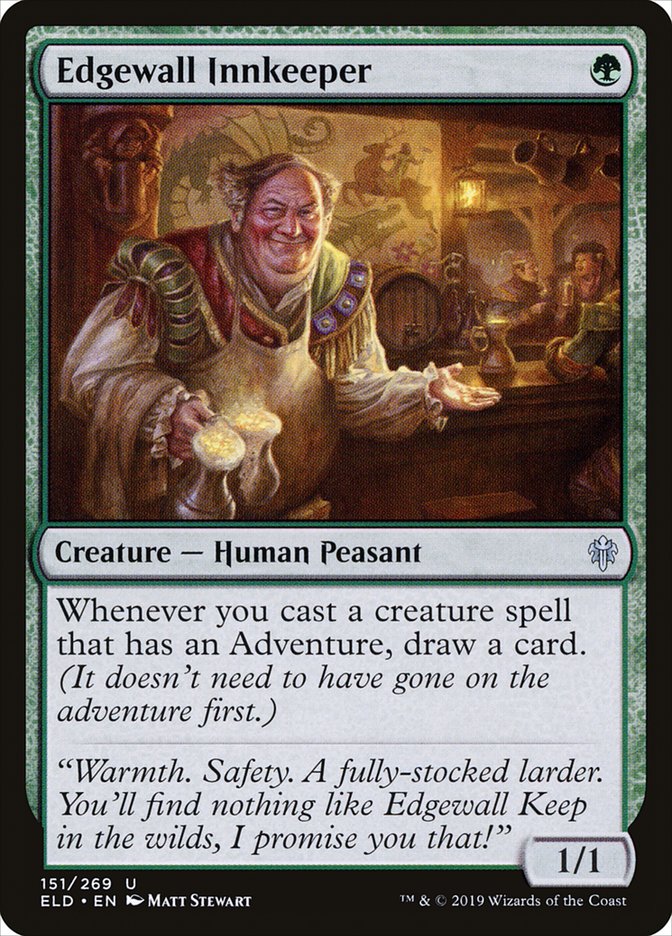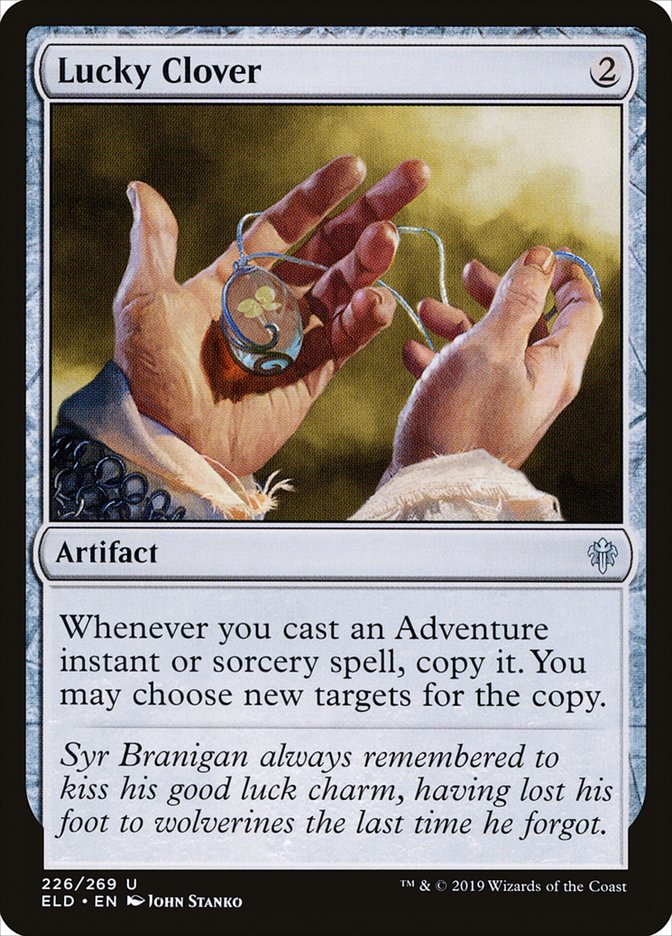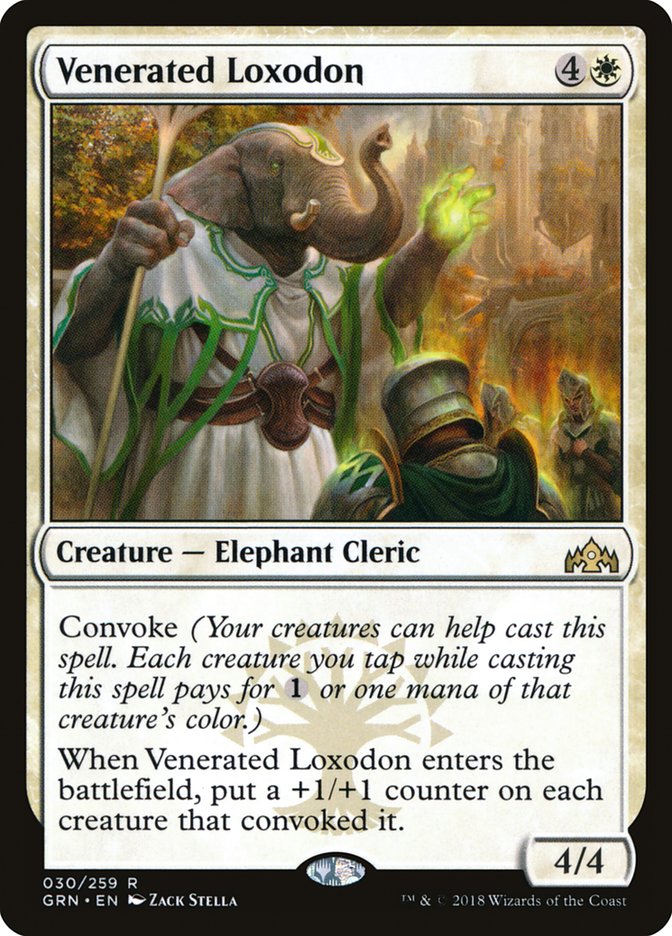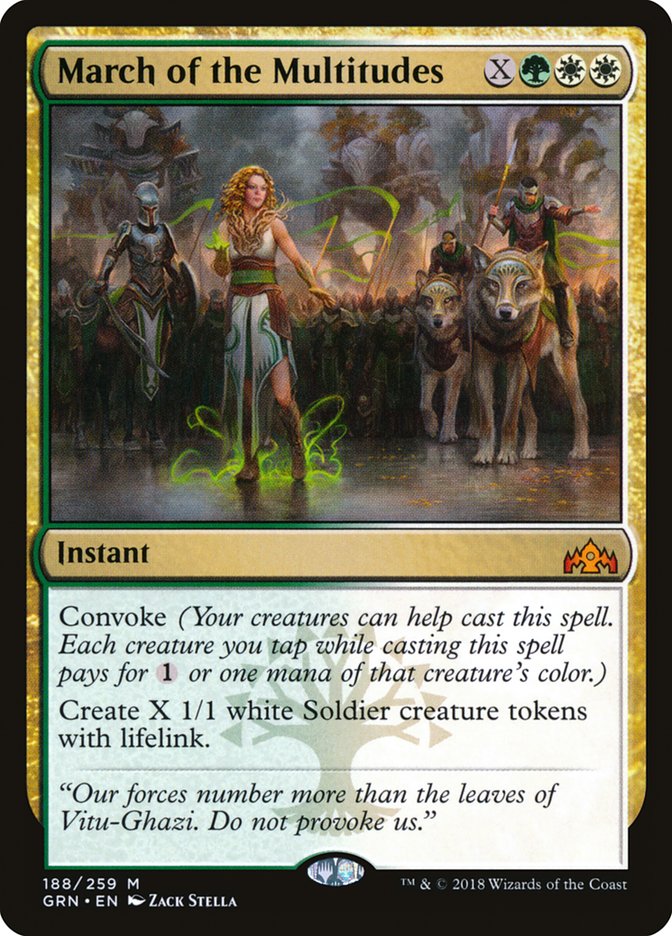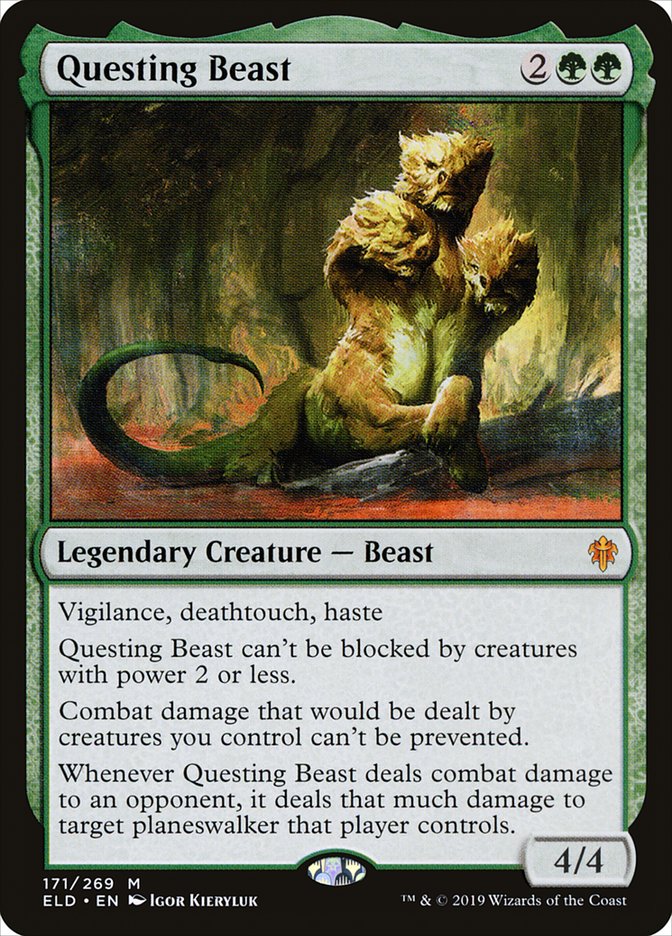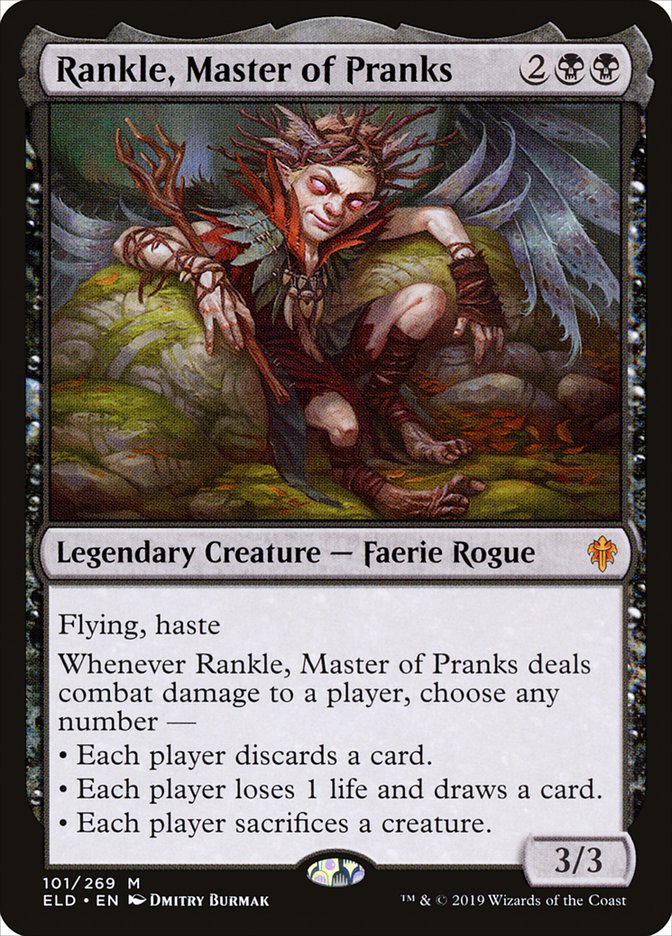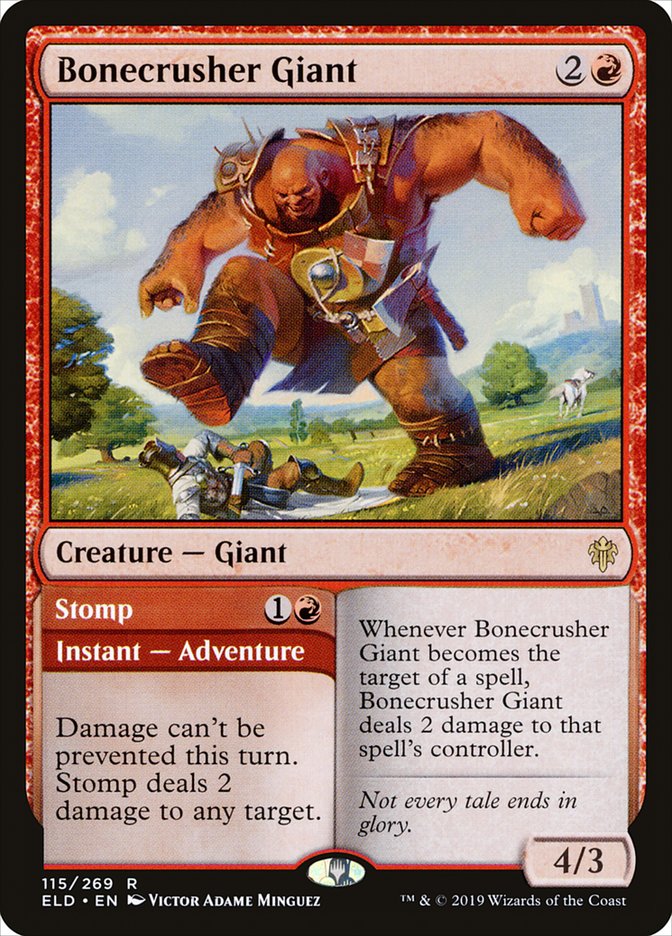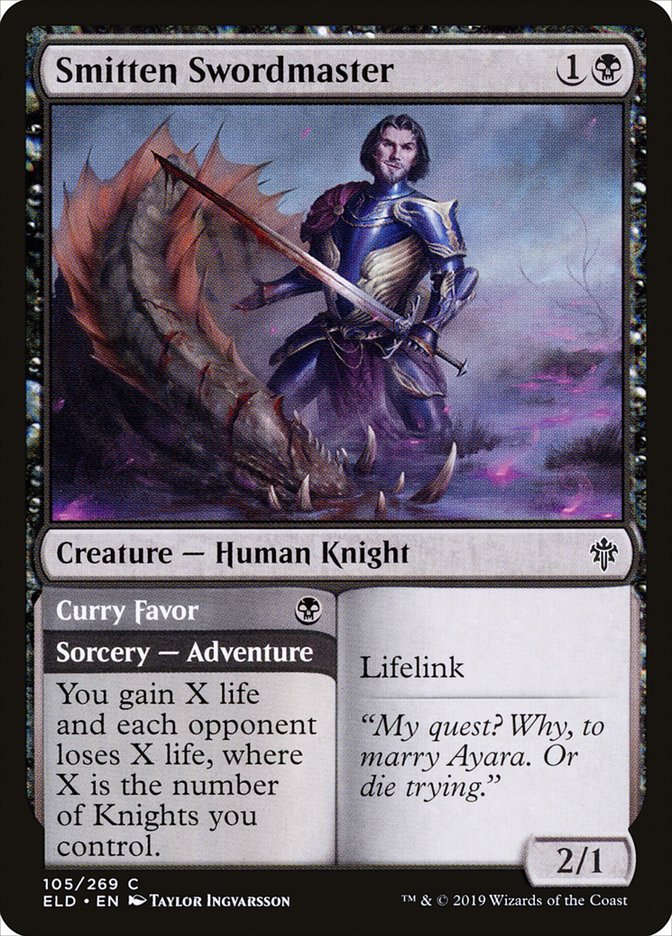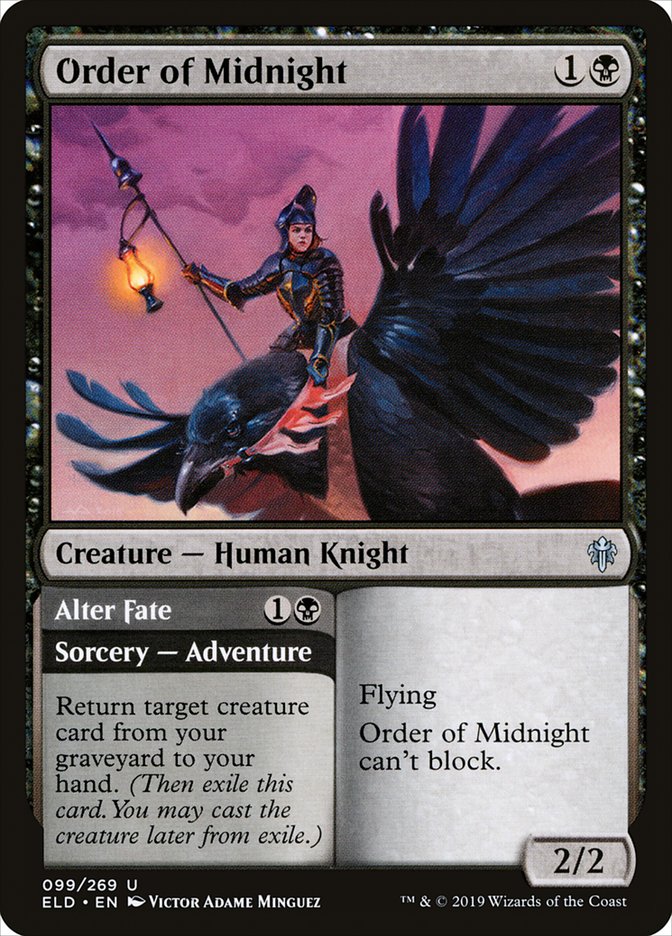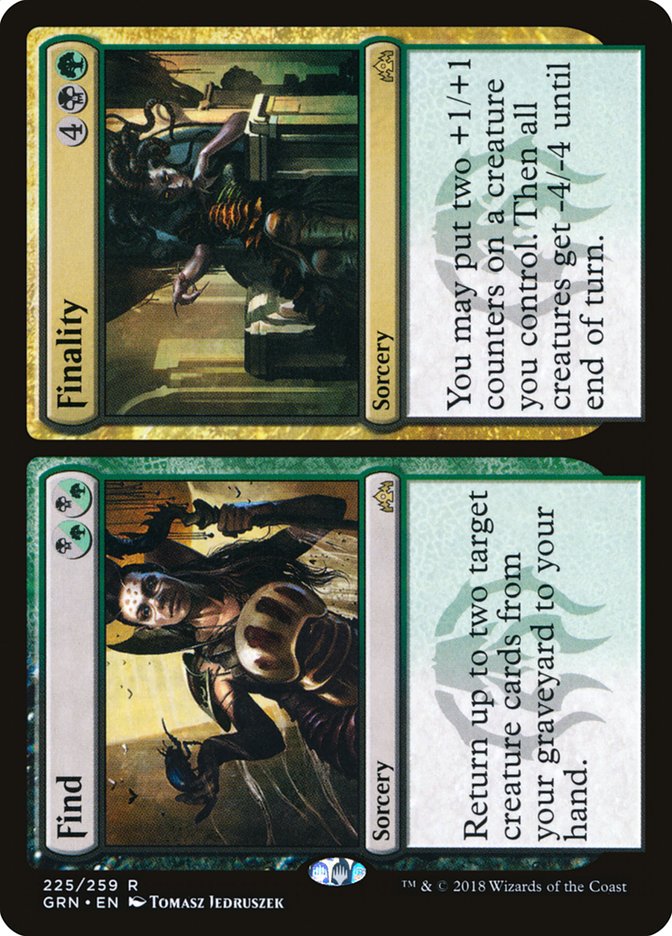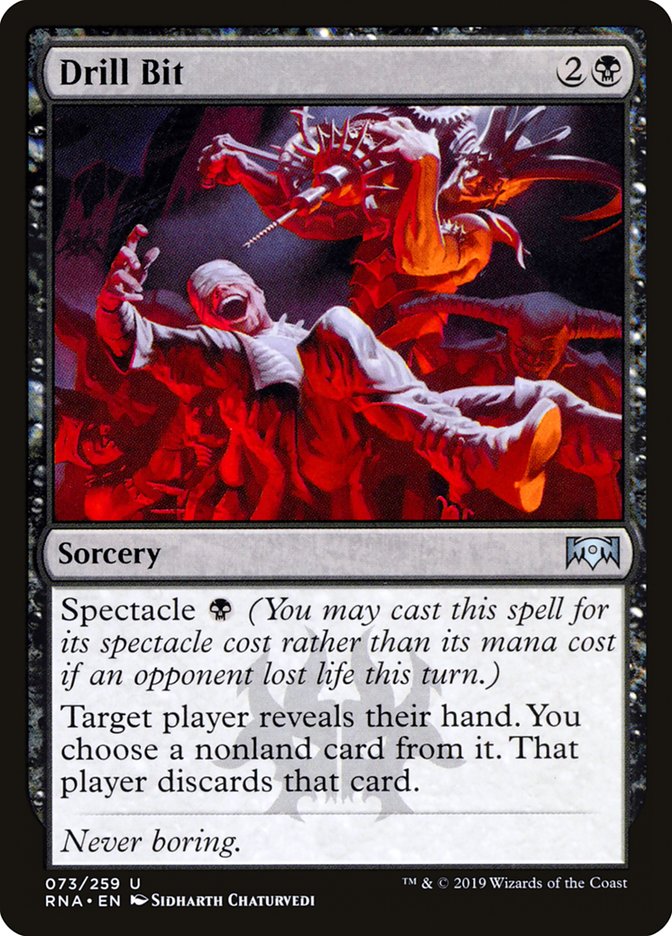When I first saw the Adventure build-arounds, I assumed they were meant for Limited. I was quickly disabused of that notion after getting smashed by some Adventure builds, and soon enough I was building my own Adventure decks and smashing people in return. In today’s article I’m going to analyze the different Adventure decks you can play and tell you which one I like the most.
There are two very powerful Adventure build-arounds in Throne of Eldraine Standard: Edgewall Innkeeper and Lucky Clover.
Whether you play one, the other, or both, your Adventure deck is very likely to be aggressive – at least all the current builds are – and it’s going to be more resilient than most aggro decks, because both the build-arounds provide card advantage and the Adventure mechanic is in itself a source of it. This results in aggro decks that are in general stronger against removal spells and people trying to one-for-one them than we’re used to.
Selesnya Adventures
Creatures (26)
- 1 Emmara, Soul of the Accord
- 4 Venerated Loxodon
- 2 Trostani Discordant
- 2 Flaxen Intruder
- 4 Lovestruck Beast
- 4 Faerie Guidemother
- 4 Giant Killer
- 4 Edgewall Innkeeper
- 1 Shepherd of the Flock
Lands (21)
Spells (13)

This is the most explosive of all the Adventure decks, and the one that utilizes Innkeeper’s status as a 1/1 creature the best. In most other Adventure builds, the Innkeeper is basically an enchantment that they can kill, as it very rarely attacks or blocks. In this deck, you’re using the Innkeeper as an actual creature to convoke Venerated Loxodon and March of the Multitudes and you’re pumping it with Flower // Flourish, Unbreakable Formation, and Trostani Discordant. The fact that you have four Venerated Loxodon and four Once Upon a Time to find them, alongside a lot of one-drops, many of which cantrip with Innkeeper, means it’s not rare to have ten or more power on the battlefield on Turn 3.
That said, even though this has the highest ceiling of all the Adventure decks, it’s not the one I recommend because it’s the least resilient and has the least amount of reach. The Adventure creatures do offer some resiliency, but you’re still reliant on getting multiple things on the battlefield, and you don’t bounce back as easily from any sort of sweeper. On top of that, you can’t interact with anything that isn’t a four-power creature. You’re very good at doing your thing, but once you do it, then you have to hope it’s enough, because you certainly can’t stop them from doing theirs.
You can also play Aaron Barich version. It has less of a tokens theme (no March of the Multitudes, for example) and more individual power with four copies of Questing Beast. I’ve personally liked March of the Multitudes in that deck, but Questing Beast is excellent against Bant Golos, so I understand the swap.
Creatures (30)
- 1 Knight of Autumn
- 4 Venerated Loxodon
- 2 Flaxen Intruder
- 4 Lovestruck Beast
- 4 Faerie Guidemother
- 4 Questing Beast
- 4 Giant Killer
- 4 Edgewall Innkeeper
- 3 Shepherd of the Flock
Planeswalkers (1)
Lands (21)
Spells (8)

Golgari Adventures
Golgari Adventure decks come in two main forms, with and without Lucky Clover. Here’s the version without Lucky Clover that Piotr Glogowski (also known as Kanister) piloted to a win in his division of the MPL split:
Creatures (26)
- 1 Massacre Girl
- 3 Rankle, Master of Pranks
- 4 Foulmire Knight
- 2 Order of Midnight
- 4 Lovestruck Beast
- 4 Murderous Rider
- 4 Questing Beast
- 4 Edgewall Innkeeper
Lands (23)
Spells (11)

This is also not a dedicated Adventure deck but more like a Golgari aggro deck with an Adventure sub-theme. Of all the Adventure decks, this is the version with the highest individual power. Cards like Questing Beast and Rankle, Master of Pranks are powerful enough to carry a game by themselves, which means the deck is not as reliant on synergy as other versions. The counterpoint is that, if you do get going, this deck is the one that does the least broken things.
There’s also a lot more removal in Piotr’s deck than in any other Adventure build, including other Golgari builds I’ve seen. This helps it play more like a regular deck with the Adventure subtheme as an afterthought.
There’s a lot I like about Piotr’s deck. Questing Beast and Rankle, Master of Pranks are two of my favorite cards in this format for how well they match up against Golos decks while still being powerful against almost everyone else. That said, I’m a huge fan of Order of Midnight in these decks as well – you have many important cheap creatures – and Piotr’s two copies are very puzzling to me. I would probably remove a Massacre Girl and an Assassin’s Trophy for the extra two copies of Order of Midnight.
Rakdos Adventures
The other side of the spectrum is the Rakdos Adventures build, which eschews Edgewall Innkeeper (obviously) but plays Lucky Clover. Lucky Clover has severe deckbuilding constraints, but once that cost is paid it becomes a very powerful card. A completely normal curve is Turn 2 Lucky Clover, Turn 3 Adventure spell (either Bonecrusher Giant or Murderous Rider), and at that point your Clover is already paid for! For the rest of the game, you’re getting to double your Adventure effects for no extra cost, and they range from killing creatures to bringing your creatures back to drawing cards to simply killing your opponent.
Here’s a potential decklist:
Creatures (35)
- 3 Midnight Reaper
- 4 Knight of the Ebon Legion
- 2 Rankle, Master of Pranks
- 4 Foulmire Knight
- 4 Smitten Swordmaster
- 4 Order of Midnight
- 4 Murderous Rider
- 4 Bonecrusher Giant
- 2 Blacklance Paragon
- 4 Stormfist Crusader
Lands (22)
Spells (3)
Sideboard

Some of the Adventure cards are good enough to see play regardless of what we’re doing. The aforementioned Bonecrusher Giant and Murderous Rider, for example, are just cards that people play in regular decks. I’d argue that Order of Midnight is also a powerful enough card to see play on its own – it’s not very popular right now, but I include it in a lot of my decks. So, even though this is a Lucky Clover deck, and there are cards in here that are only played because of Lucky Clover, you’re not suffering that much in quality if you don’t draw it or if it’s removed.
This deck plays a bit differently from the other two. It’s a regular aggro deck (lower to the ground than Piotr’s Golgari Adventure) that uses Lucky Clover as a finisher alongside Bonecrusher Giant and Smitten Swordmaster. It might not seem like much, but the burst potential of these cards is incredible once they’re doubled or tripled, especially considering you have Order of Midnight to bring them back. It’s possible to kill an opponent without ever entering combat.
Lucky Clover means the deck can play several different types of games. First, you can simply play a normal Rakdos Knights game, cast some creatures, and attack them to death. Second, you can play the “get some early damage in and burn them out” game, similar to Mono-Red builds of old. Third, you can play a grindy game, as recurring Order of Midnights make sure you never run out of steam and doubling up on both Murderous Raider and Bonecrusher Giant actually lets you kill the cards your opponent casts.
This deck has two issues. First, the cards aren’t individually as powerful as the ones in Golgari, as you don’t have a Questing Beast of your own or even something like Lovestruck Beast. Second, the mana in it isn’t perfect. Temple of Malice isn’t legal and you have early-drops that punish you for having lands enter the battlefield tapped, and this deck is very mana-intensive in general.
Golgari Adventures Knights
Then there’s the amalgamation of all lists, a Golgari build that runs both Edgewall Innkeeper and Lucky Clover. As an example, here is John Rolf build from the MPL:
Creatures (27)
- 3 Knight of the Ebon Legion
- 4 Foulmire Knight
- 4 Smitten Swordmaster
- 4 Order of Midnight
- 4 Lovestruck Beast
- 4 Murderous Rider
- 4 Edgewall Innkeeper
Planeswalkers (1)
Lands (23)
Spells (9)
Sideboard

This is the grindiest of builds, as it runs the card advantage from both the Innkeeper and the Clover. Since you’re drawing so many extra cards and you’re doubling up on Raise Deads from Order of Midnight and Find // Finality, it’s almost impossible to run you out of resources. People can go under or over you, but they will never exhaust you.
The Rakdos deck is more about getting some early damage in and then draining them; this deck, on the other hand, is more about grinding and amassing resources and eventually killing your opponent in a big turn. When I play it, it’s not uncommon that I untap with a battlefield of Lucky Clover and two 1/1 Knights and then I drain them for fourteen damage when all is said and done. Basically, the difference is that in this version of the deck, the games where you drain them go a lot longer (though you can also just kill them with Lovestruck Beast beatdown) and draining them is the gameplan, as opposed to finishing off what the creatures already started.
This is my favorite version of the deck, though I’ve made several changes from John Rolf build. Here’s what I’ve been running:
Creatures (29)
- 3 Midnight Reaper
- 4 Knight of the Ebon Legion
- 4 Foulmire Knight
- 4 Smitten Swordmaster
- 4 Order of Midnight
- 2 Lovestruck Beast
- 4 Murderous Rider
- 4 Edgewall Innkeeper
Lands (22)
Spells (9)

This list takes a more aggressive approach than Rolf’s, moving more towards the Rakdos Knights end of the spectrum and replacing Find // Finality with Midnight Reaper as an extra card advantage mechanism. Between Order of Midnight, Midnight Reaper, and Edgewall Innkeeper, it’s really hard to grind you out, and your explosive turns don’t need to be as explosive (since they are likely to be lower) and are also easier to achieve (since you run more Knights). What you’re giving up for that is some removal and a powerful card in Lovestruck Beast, but I think the gains are worth it if the metagame is right for it. Midnight Reaper is much better against a deck like Bant Golos, but much worse against decks like Mono-Red and Gruul Midrange, so it’s going to depend on what you expect to play against.
Another key difference is that I run four copies of Once Upon a Time. I agonized over whether this card was even worth including for a while, since you draw so many cards and have so much to do with your mana, but I think there are enough important creatures to find at different points of the game that it’s worth having. A hand with a Turn 1 Innkeeper, for example, is significantly better than one without, and later on, finding that key Order of Midnight or Smitten Swordmaster is very valuable. This is also a deck that can get mana-hungry, so being able to find a land with it early on comes up.
For the sideboard, one thing I’m sure of is that you want Drill Bit over Duress. The fact that Duress can’t take either Golos, Tireless Pilgrim or Realm-Cloaked Giant is a huge liability in the matchup it’s supposed to be the best at, to the point where I’d rather have the card that I sometimes have to pay three mana for.
This deck isn’t the best at attacking, but the decks you’re targeting with Drill Bit (Bant Golos, Fires of Invention builds, Doom Foretold) are even worse at blocking, so Drill Bit still costs one mana most of the time. In these matches, I’m also a fan of Reaper of Night. It’s a bad card by itself but it’s awesome with Lucky Clover, and it justifies keeping Clover in your deck in matchups where you’d want to sideboard out some Adventure cards like Murderous Rider.
Against the aggro decks, you get the remaining Lovestruck Beasts (this card really is excellent versus red decks) and Cavalier of Night, which is a card I’ve learned to like. It’s not as good here as it is in most Mono-Black builds, as you don’t have sacrifice outlets or a very high value target to return, but it’s still a very good card versus the green and red decks.
Overall, I think all the Adventure builds are fun and competitive, and I urge you to give them a try if you haven’t yet. To recap:
- Selesnya Adventures: The most explosive. Your high-end is unmatched and you’re very consistent at doing what you do, but you’re also the most vulnerable since you don’t have reach or interaction.
- Golgari Adventures: The most removal and the most powerful individual cards. Plays like a Golgari Midrange deck with an added angle of Adventures.
- Rakdos Adventures: An aggro deck with a lot of reach and the potential to grind, but the manabase leaves a little to be desired.
- Golgari Adventures Knights: A hybrid between all the builds, the best at grinding and is trying to set up a big combo turn. This is my favorite build.


